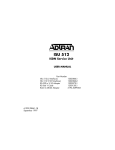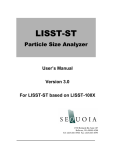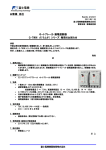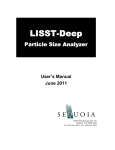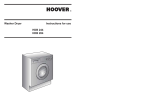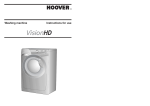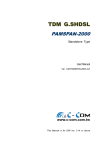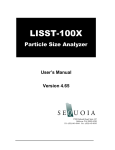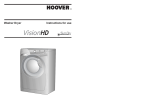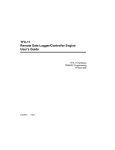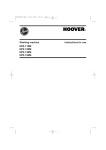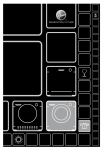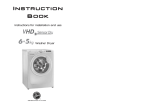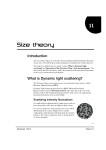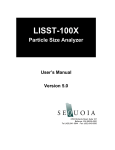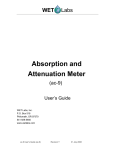Download User`s Manual - Sequoia Scientific, Inc.
Transcript
LISST-25X Suspended Sediment Sensor Operating Manual Version 1.3 2700 Richards Road, Suite 107 Bellevue, WA 98005 Tel: (425) 641-0944 Fax: (425) 643-0595 Welcome to the LISST-25X Suspended Sediment Sensor Technical Specifications of the LISST-25X • • • • • • • Parameters Measured -Particle Volume Concentration (µ/l) -Sauter Mean Diameter (SMD) -Optical Transmission -Depth (meters) Optical Path -2.5 cm optical path Operating Range -Concentration: Approximately 0.1 to 1,000 mg/l with 30 micron (limits change linearly with particle size) -Size Range: 2.50-500 µm (Full Range) 63 - 500 µm (Sub-range) -Transmission: 0 – 100% (optimal range for measuring concentration and SMD: 30-98%) Data Storage -28,000 recordings of measured parameters Power Supply -Internal 4 x 9V alkaline batteries -External 6-12V DC @ 250 ma maximum Physical Dimensions -3.5” diameter x 18” long (8.0 cm diameter x 45 cm L) -8.0 lbs (3.6 kg) in air -2.0 lbs (0.9 kg) in water Depth Rating -300 meters © This document is the property of SEQUOIA SCIENTIFIC, INC. It shall not be reproduced, disclosed, used in whole or part, for any purpose, without the specific written authorization of SEQUOIA SCIENTIFIC, INC. Table of Contents SECTION 1: INTRODUCTION………………………………………………1 SECTION 2: OPERATION……………………………………………………3 2.1 Introduction………………………………………………………...…….3 2.2 Getting Started……………………………………………………………3 2.3 Field Deployment Procedure…………………………………………….9 2.4 LISST-25 Command Summary………………………………………….11 2.5 LISST-25 Command Details……………….…………………………….13 Appendix A: Data Formats………………………………………………..21 file Appendix B : LISST-25X Reset Procedure.…………………………………..22 Appendix C : Warranty………………………………………………………..24 Appendix D : Alternate Terminal Software……..………..…………………..26 WARNING The LISST-25X contains a laser diode emitting a maximum of 5 mW of visible (red) light at a wavelength of 670nm. The laser beam under normal circumstances is not a threat. However, if objects are placed in the path of the laser beam, the light could be reflected into the eye causing permanent damage. Technical assistance To obtain technical assistance please contact your local distributor or a Sequoia Technical Service Representative listed below. Please be sure to include the serial number with any correspondence. Factory Technical Service Representatives Chuck Pottsmith Email: [email protected] Tel: (425) 641-0944 ext. 107 Doug Keir Email: [email protected] Tel: (425) 641-0944 ext. 104 Introduction The LISST-25X Laser Suspended Sediment Sensor provides a new level of accuracy in measuring the size and concentration of suspended sediment. In-situ measuring devices such as optical transmissometers, optical backscatter, and acoustic devices have a limitation whereby the signal is highly dependent on the size of the material being measured. The easiest way to emphasize this limitation is to describe a simple experiment. Start by filling one glass container with a known mass of fine material and a known amount of water. Place an equal mass of coarse sand into the same amount of water in a second glass container. Both containers will have the same mass concentration. If you stir the solutions and look through the glass containers, you will see that light can easily pass through the container with the larger material. The container with fine material is much cloudier. if not opaque. This difference is due to completely different optical transmission and optical backscatter properties. Similarly, the acoustic properties are greatly different. The commonly used single parameter sensors noted above will record two very different values for the same concentration. The example just described uses a large change in sizes to emphasize this point. Many users of sensors other than the LISST25X, have gone to great lengths to try to calibrate their instruments. Many use bottom samples at the site of interest to calibrate their sensors. This calibration will provide a constant that produces a linear response to concentration. However, the problem with this approach is that the sample used for calibration may or may not be what is seen in the water column. The size distribution can change dramatically by the location, both horizontal and vertical, or over time. Small changes in the size distribution can cause errors up to a factor of ten in concentration measurements for these single parameter sensors. The advantage of the LISST instruments are that they simultaneously measure the scattered light a many angles and thus can automatically compensate for changes in the distribution. Sequoia’s initial laser instrument, the LISST-100 Particle Size Analyzer, was developed to provide detailed measurements of size distribution and concentration of particles in-situ. In many studies, the detailed size distributions are not required. Only accurate measurements of the total mass concentration are required. The LISST-25X was developed to provide this specific measurement. The LISST-25X is based on the same principles of laser light scattering as the LISST-100. The Mie-theory of light scattering suggests that collimated laser light illuminating particles will scatter most of its energy at particular angles. Small particles scatter their energy at larger angles and large particles at smaller angles. By recording the scattering at different angles, the LISST-100 can mathematically invert the scattering to find the size distribution and concentration of particles in the water. The LISST – 25X User’s Guide 1 LISST-25X obtains the mean size and total concentration using a different approach. By weighting the scattering in a particular way the total area concentration and total volume concentration can be obtained. The ratio of volume and area gives the mean size. This technique is very unique and Sequoia Scientific has obtained a patent on this concept. Figure 1 below shows a schematic of the optical layout of the LISST-25X. Figure 1: Schematic of the optical path of the LISST-25X. The laser is collimated by the small lens on the left. The collimated laser light passes through the water. Particles in the water scatter the light which is collected by the larger receive lens. The specially shaped detectors are place at the focal plane of the lens. The unscattered light passes through a small hole in the center of the detector and is measured by a photodiode as optical transmission. The advantage of this approach is that the total volume concentration is obtained regardless of the size distribution. For the LISST-25X, the range of particles measured is 1.25 to 250 microns. Too many particles outside this range will cause measurement errors. An extremely heavy concentration of particles causes a condition called multiple scattering. Multiple scattering arises when scattered light from particles is re-scattered by other particles. The theory used to convert the scattering measurements to a concentration value loses accuracy when there is multiple scattering. When there is concern about the possibility of multiple scattering, a general rule is that this effect occurs when the optical transmission has dropped to 30% of its clean water value. As the transmission level drops below 30% the error in the measurement of concentration will increase. Similarly, a very low concentration of particles will cause a noisy estimate of volume concentration and the mean size. The LISST-25X will perform best when the optical transmission is between 95% and 30% over the 2.5cm path. The LISST-25X is designed to be either a stand-alone instrument or a complimentary sensor to a suite of instruments. It contains a built in battery and datalogger. It also has the ability to be externally commanded and powered. By using simple two letter commands, the user or master datalogger can control the instrument to take a sample and transmit the mean size and total concentration in calibrated units of microns and microliters per liter. LISST – 25X User’s Guide 2 Operation 2.1 Introduction This section is designed to provide the user with quick access to the basic principles of operation including Field Deployment (Section 2.3), Command Summary (Section 2.4), and Command Details (Section 2.5) in detailed step-by-step instructions. 2.2 Getting Started Please check that the following items have been included in the LISST25X shipping case: Contents of shipping case 1. 2. 3. 4. 5. LISST-25X instrument Operating Manual with software disk. Plastic instrument stands (2) Communications cable Horizontal test chamber The LISST-25X Suspended Sediment Sensor is shipped ready to deploy. It comes pre-programmed and in “sleep” mode. Step 1: Remove Instrument from shipping case Begin by removing the two white plastic instrument stands and set them on a flat working surface. Remove the LISST-25X from its case and set it on the stands. The LISST-25X has two distinct ends that are referred to as the Optics endcap and the Connector endcap. The connector endcap has an underwater connector that is used for communication and external power. The internal batteries are mounted to a removable board that is accessed by unscrewing the connector endcap. The optics endcap contains the optical windows that the laser beam passes through to take a measurement. The internal optics and electronics are mounted to the inside of this endcap. Step 2: Install test chamber Remove horizontal test chamber from the shipping container. This test chamber allows the LISST-25X to be used and tested in the laboratory. Insert the optics end of the instrument into the chamber. Fill the chamber with clean filtered water. Make sure there are no bubbles attached to the windows. LISST – 25X User’s Guide 3 Step 3: Install Communications software Install the communications software provided on the Software Disk by following the instructions printed on the disk label or in the README.TXT file included on the disk. Step 4: Connect Communications cable Remove the Communications cable from the shipping container. Remove the protective cap from the underwater connector on the LISST-25X. Attach the Communications cable to the connector making sure to align the pins. Attach the other end of the Communications cable into the serial port of the PC. NOTE: Always replace the protective cap on the connector before deploying the instrument. Step 5: Establish communications with instrument button. A Execute the LISST-25.EXE program and press on the terminal window will appear. If you are using the program for the first time, you may need to set the terminal window settings. The default baud rate is 19200 with 8 data bits, no parity, and 1 stop bit. Make sure that the proper communication port is selected. These settings are accessed by choosing the Settings option of the File menu. Clicking on the Serial Port tab will display the current settings. “ The LISST-25X is shipped in its sleep mode or low power mode. Every 10 seconds “Deep Sleep…Enter ZZ to wake up” will be printed to the screen. To wake the instrument, zz must be sent within 2 seconds of the message being printed to the screen. To wake the instrument, enter zz in the box to the left of the Send button. When the message is displayed click on the send button or press Enter. The LISST-25X should respond with an L-25>> prompt. With the command box empty, the instrument will respond with L25>> prompt each time the <enter> key is pressed. Step 6: Display the instrument status At the prompt enter “DS” to display the instruments status. Text similar to the following should appear: L25>> L25>>DS Current Status of LISST-25X LISST-25X Serial #25-001 Maximum Memory: 28103 Samples Memory Used: 0 Samples Memory Available: 28103 Samples Samples per Average = 10 Calibration Constant = 17500 Sample Rate = 1 Background File Date/Time: 02/23/99 12:03:23 Battery Voltage: 9.23 Current Date: 3/23/99 Current Time: 23:34:45 L25>> LISST – 25X User’s Guide 4 Step 7: Set the instruments internal clock The internal instrument clock can be set in two ways. The first method is Step 8: Acquire clean water background measurements Before accurate measurements can be made, the background light scattering of the optical surfaces must be measured. This background is subtracted from the measured scattering in the field so that only the scattering from the particles in the water are used for processing of the data. The instrument will need to be submerged in clean filtered water. Check to make sure the windows and water are free of bubbles. The “ZS” command will acquire and store the necessary background measurements for later use. If there is a problem such as dirty windows or optical misalignment messages will be displayed to the screen. Step 9: Add Sample and Display results We can now add material to the water to take actual measurements of suspended solids. Add the material and make sure it is well mixed. At the prompt enter “GX”. The date and time, total volume, mean size, and optical transmission will be displayed to the screen. The LISST-25X only measures volume, not mass. The instrument is shipped with a Calibration Constant that has been computed using a density of 1. The Calibration constant can be adjusted by using the command “SC”. For example, you can convert the standard units of micro-liters per liter to milligrams/liter by dividing the standard calibration constant by the density. Step 10: Load a Batch File The LISST-25X is designed to be a self-contained instrument. One of the features that support this functionality is the ability to load and execute a list of commands. A batch file of up to 25 commands can be loaded into memory. Commands for creating loops, both fixed length and continuous, are also provided. button. This will set the instrument clock to the by clicking on the PC clock time. The second method is by using the ST command. Enter ST in the command box and press enter. Messages will prompt you for the date and time. You can also enter the date and time after the ST command to bypass the prompts (e.g., ST 01/05/2003 21:05:03). [Note that the year is four digits and the hour is in 24-hour format.] Start by loading the first line of the batch file with the command for displaying the status of the instrument (“DS”). Enter “LB 01 DS”. This will load batch line 1 with the DS command. The commands can be entered in either capital or lowercase letters. The batch line value following the “LB” command MUST be two characters. Let’s add a few more lines to setup this example. Type in the following lines at the L25>> prompt. LB 02 GR 5 LB 03 WT 20 LB 04 GT 2 Line 2 will get 5 samples at the sample rate selected by the SR command, LISST – 25X User’s Guide 5 display the results to the screen, and store them in the flash ram datafile. Line 3 will wait for 20 seconds before continuing to the next batch line. Line 4 will return to batch line 2. This batch file will take data continuously until the memory fills or a “CTRL-C” is entered. Step 11: Execute a batch file To view the current contents of the batch file enter “BP”, short for Batch Print. The following text will be printed to the screen. L25>> L25>>BP Batch File in Memory Line Command Line Command ------------------------------1 DS 14 2 GR 5 15 3 WT 20 16 4 GT 2 17 5 18 … … 12 25 13 L25>> Enter “BS”, short for Batch Start, to start the execution of the batch file. As each sample is taken a green LED on the connector endcap will light. This can be very useful in visually confirming that the instrument continues operating before deployment. Step 12: Download stored data The batch file will continue until Stop button is pressed or a CTRL-C is entered. Stop or CTRL-C will exit to the main prompt. Enter a “DM” command. The amount of samples stored in memory will be displayed to the screen. To download the data, choose Download from the LISST-25 menu. Enter a file name for the binary file to be downloaded. We suggest using an extension of .dat. The data will remain in memory until the Erase option of the LISST-25 menu is executed. LISST – 25X User’s Guide 6 Step 13: View downloaded data with LISST25.EXE windows program Once the data has been downloaded, the binary file can be converted to an ASCII file using the LISST25.EXE program. The LISST25.EXE program will also display the results to the screen. Start the program and select Open Raw Data File from the File menu. Select the file to be opened. A display similar to the one shown below will be displayed. Special Note: Because the LISST-25X has data for two size classes the two windows will be opened. One window will contain the Volume Concentration and Sauter Mean Size for the full size range and the other window will contain the Concentration and Sauter Mean Size for the subrange. Step 14: Select output options for the downloaded data. In order to save the file to an ASCII file, the correct setting must be selected in the Output Options window as shown below. After making and accepting these selections, an ASCII file with the same name and an extension of .LOG will be created. The options for LISST – 25X User’s Guide 7 formatting the date and time allows the file to be compatible with a variety of programs such as Matlab and Excel. Step 15: Select display options for viewing the data. The scales and appearance of the plots can be changed by selecting the Settings option from the Display menu. A window similar to the one below will appear. Select the “Save values as Default” box to store the setting for future use. Step 16: Print Preview and Print data. LISST – 25X User’s Guide Select Print Preview from the File menu to display a preview of the page to be printed. A screen similar to the one shown below will appear. If the plot is too large for the page its size can be adjusted using the value for Plot Window Width in the Settings control window acessed from the Display menu. 8 2.3 Field Deployment Procedure Introduction This section is designed to introduce the procedures required for deploying the LISST-25X. It gives step-by-step instructions to setup and deploy the instrument in the field. The steps presented here assume that the user has learned the basic operating procedures covered in the preceding Getting Started section. Step 1: Check Battery voltage and replace if required Prior to starting a field experiment, check the battery voltage by using the DB command. The battery voltage will be printed to the screen. The batteries are mounted to a single card that can be accessed by removing the connector endcap. The connector endcap is attached to the case using three #6-32 socket head cap screws. To remove endcap, remove the three screws and gently remove the endcap with a slight twisting motion. Be careful not to pull the wires attached to the inside of endcap too far from the case. Step 2: Replace batteries The batteries are mounted to a card. To replace the batteries, remove the card by lifting on the white levers. The card should slide out. Replace the four 9-volt batteries and re-insert the card. Make sure the card fully engages the edge of the connector and that the white levers are locked in to place. Standard Alkaline batteries are recommended. Lithium 9V batteries can also be used to extend the battery life. Step 3: Re-install the endcap Clean and lightly grease the o-ring and the sealing surfaces of the pressure cases. Carefully insert the cables into the case and press the endcap on to the instrument making sure not to pinch any wires. Replace the three #6-32 screws. The o-ring is a radial seal and is not dependent on the screws. Therefore is not necessary to torque the screws. The need only to be snug. Do not overtighten as the stainless screws can damage the aluminum case if overtightened. Step 4: Mount the instrument Mount the instrument to the frame or cage. For longer deployments, it is recommend that the instrument be mounted horizontally. This will keep the optical windows in a vertical orientation and thus reduce biofouling. LISST – 25X User’s Guide 9 Step 5: Record a background scatter measurement Before deploying the instrument, a background scatter measurement must be recorded. Place a clean bag or the horizontal test chamber over the instrument and execute the “ZS” command. Step 6: Program a Batch file Load the batch file with the desired commands using the “LB” command. Display the batch file using the “BP” command. Start the batch file with the “BS” command. Step 7: Deploy the instrument Disconnect the Communications cable. Attach the connector plug and deploy the instrument. The green LED on the endcap can be used to see if the instrument is still running as programmed. Step 8: Recover the instrument Upon recovery, rinse and dry the area around the connector endcap. Reconnect the Communications cable. If the instrument has been deployed for an extended period of time it is recommend that 9V be applied to the external power connector of the Communications cable. This will supplement any remaining battery power and eliminate the possibility of batteries dying during downloading of the data. Open the LISST-25 or TFTOOLS program and stop the running program by hitting the Stop button or by typing CTRL-C. Type DS to display the current status. Step 9: Download and Process Data Download and process the data using the LISST-25 software. LISST – 25X User’s Guide 10 2.4 LISST-25X Command Summary Display Commands DB Display battery voltage DM Display memory remaining DS Display current status information DT Display time HE Display general help messages and command list Setup Commands RB RS Hard Reboot to restore factory defaults, time, and internal calibrations and constants. Reset to factory defaults settings SA x Set samples per average equal to x SB x SC x Set communications baud rate to x , where x = 300, 600, 1200, 3400, 4800, 9600, 19200, or 38400 Set Calibration Constant equal to x SF x Set output format where x = sample code SM x Set output display mode to x code SR x Set sample rate, where x= seconds between samples ST mm/dd/yyyy hh:mm:ss Set time and date, where mm=month,dd=day,yyyy=year,hh=hour(24 format),mm=minute, ss=seconds, Example: ST 01/05/2001 21:05:03 Acquisition/Action Commands GR Grab and store samples as set rate GS Grab sample and store GX Grab sample and transmit it XS transmit last sample ZS Acquire and store Zscat ZZ Go into deep sleep mode (minimum power consumption) LISST – 25X User’s Guide 11 Batch File Commands BP Print batch file to screen BS Batch file Start command CB Clear Batch file from memory EB Exit Batch file GT x Goto batch command line x, x=1 to 25 LB xx cmd Load batch command line x with cmd string, x=01 to 25. Note: command line must be two digits. Repeat code between RP and ER (end repeat) commands x times Wait x seconds from last WE command. Use WE 0 to reset timer. Wait x seconds before returning RP x, ER WE x WT x LISST – 25X User’s Guide 12 2.5 LISST-25X Command Details Display Commands DB Display battery voltage Syntax: DB or db Description: Display main battery voltage to the screen. Units are in volts. If battery voltage is below the suggested level a warning will be displayed. Example: input: DB results: Battery voltage =8.98 volts Cautions: Using the instrument with voltage levels below recommended levels could result in unreliable data. DM Display memory remaining Syntax: DM or dm Description: The memory of the LISST-25X is non-volatile EEPROM. As data is written to memory, the amount of available memory can be accessed by the DM command. The amount of available memory is then displayed. The units will be in number of samples. Example: input: DM output: Memory available: 28103 samples See also: The DS, Display Status command will also show the number of bytes available in the data file. DS Display current status information Syntax: DS or ds Description: The instrument settings and status are displayed to the screen. Example: input: DS output: LISST – 25X User’s Guide Current Status of LISST-25X LISST-25X Serial #25-001 Maximum Memory: 28103 Samples Memory used: 0 Samples Memory Available: 28103 Samples Samples per Average = 10 Calibration Constant = 17500 Sample Rate = 1 Background File Date/Time: 02/23/99 12:03:23 Battery Voltage: 9.23 Current Date: 3/23/99 Current Time: 23:34:45 13 DT Display time Syntax: DT or dt Description: The current time and date are displayed to the screen. Example: input: DT output: Current Date: 04/06/2000 Current Time: 15:07:57 Cautions: The time is reset to midnight Jan 1, 1980 at power up. To reset time see ST command. HE Display general help messages and command list Syntax: HE or he Description: Displays the list of command to the screen. Example: input: HE output: LISST-25X Commands (followed by 30 lines of text) Cautions: None Setup Commands RS Reset to standard defaults Syntax: RS or rs Description: Returns all settings to startup defaults. Does not effect datafile, batch file, or clock. A warning prompt will ask you if you are sure you want to reset to defaults. Enter “Y” or “y” followed by a <enter> if you wish to reset. Any other key(or no key) followed an <enter> will not reset. After resetting to default parameters the current status is automatically displayed using the DS command. Example: input: RS output: Reset to Default parameters? (y or n): “Y” <enter> LISST-25X Current Status … Cautions: The calibration constant is an instrument specific value that is determined at the factory before delivery of the instrument. The default parameter may not be the correct one for your instrument. Record the current calibration constant before executing an RS command. LISST – 25X User’s Guide 14 SA Set samples per average Syntax: SA x or sa x Where x = number of samples per average Description: Each recorded or displayed measurement is based on an average of samples. The number of samples per average is set using the SA command. Example: input: SA 10 Cautions: None SB Set communications baud rate Syntax: SB x or sb x , Where x = 300, 600, 1200, 3400, 4800, 9600, 19200, or 38400 Description: The communications baud rate can be set to a number of different rates (see above). The standard default rate is 19200 (if power is reset the instrument will return to 19200 baud). Example: input: SB 9600 output: The baud rate is now set to 9600 (Note: The output message is printed at original baud rate before it is changed to the new rate.) Cautions: Resetting the baud rate does not effect the baud rate of the communication software. The baud rate of the communications software must be changed in order to continue operation. SC Set Calibration Constant Syntax: SC x or sc x Where x = value of calibration constant Description: The instrument is calibrated at the factory before shipment. The calibration constant corrects for instrument specific values such as laser power and electronic gain. The value can be experimentally determined by the user and/or adjusted for different densities. Example: input: SC 21050 Cautions: The factory calibration is in units of volume (micro-liters) per liter. LISST – 25X User’s Guide 15 SR Set sample rate Syntax: SR x or sr x, where x= seconds between samples (If no value follows command, prompts will be displayed) Description: The GR command acquires data at a fixed rate detriment by the SR command. The number of seconds between samples is set. Example: input: SR 5 Cautions: Check that the sample rate is not faster than the time it takes to acquire an averaged sample. ST Set time and date Syntax: ST: mm/dd/yyyy hh:mm:ss or st mm/dd/yyyy hh:mm:ss Where mm=month, dd=day, yyyy=year, hh=hour(24 format),mm=minute, ss=seconds If no values follow the “ST” or “st” command, prompts for entering the time and date will be displayed. Description: The LISST-25X has a built-in clock that must be reset after each power reset or power up. See Also: DT, Display Time command. Example: input: ST 01/05/2001 21:05:03 Cautions: The clock resets to 12:00 am 1/1/80 upon powering up. Acquisition/Action commands GR Grab and store samples as set rate Syntax: GR x or gr x Where x = number of samples to acquire Description: Acquires x averaged samples at fixed rate set by the SR command. Example: Input: GR 3 Output: Sample #1 Sample #2 Sample #3 Vol 5.56 5.87 5.98 SMD 130.56 140.23 150.16 Trans >63 Vol >63 SMD 0.78 1.26 150.24 0.76 1.43 160.78 0.72 1.65 165.28 Depth 2.56 2.67 2.76 The first column is concentration, the second is the mean size, the third is the percent transmission, th fourth is concentration greater than 63 microns, the fifth is the mean size of the particles greater than 63 microns, and the sixth is the depth in meters. Values are displayed to the screen and also stored to the datafile. Cautions: To stop acquisition before it is complete press the Stop button or CTRL-C. LISST – 25X User’s Guide 16 GS Grab sample and store Syntax: GS or gs Description: Acquires single averaged sample and stores it in memory. Example: Input: GS Output: (no response) Notes: Use “SA” command to set number of samples per average. GX Grab sample and transmit it Syntax: GX or gx Description: Acquires single averaged sample and displays the result to the screen. Example: Input: GX Output: 5/30/2001 23:54:34 5.34 125.56 0.65 5/30/2001 23:54:34 2.56 156.78 2.56 Format is date, time, full range concentration, full range mean size, and percent transmission. The second line’s format is date, time, >63 micron range concentration, >63 micron range mean size, and depth in meters. Notes: The GX command does not store the sample in the datafile. XS Transmit last sample Syntax: XS or xs Description: Transmits the last acquired averaged sample to the screen in the same format as the “GX” command. The sample will be from the last “GR”, “GS”, or “GX” command. Example: Input: XS Output: 5/30/2001 23:54:34 5.34 125.56 0.65 5/30/2001 23:54:34 2.56 156.78 2.56 Format is date, time, full range concentration, full range mean size, and percent transmission. The second line’s format is date, time, >63 micron range concentration, >63 micron range mean size, and depth in meters. Notes: XS command only transmits the last sample acquired ZS Acquire and store Zscat Syntax: ZS or zs Description: Acquires background scatter data and stores it in memory for future use. Example: Input: ZS Output: If the background is not within specifications warning messages will be printed to the screen. Cautions: The background will only be saved in memory while power is applied. The background resets to the factory default upon power reset or power up. LISST – 25X User’s Guide 17 ZZ Go into deep sleep mode (minimum power consumption) Syntax: ZZ or zz Description: Sends LISST-25X in to low power sleep mode. Instrument will wake up every 10 seconds and wait for a response. If there is no response with in 2 seconds, the instrument will return to sleep mode. Example: Input: ZZ Output: Deep Sleep… Enter zz to wake up Deep Sleep… Enter zz to wake up Deep Sleep… Enter zz to wake up Cautions: The background scattering data and other settings are not affected by the ZZ command. Batch File Commands BP Print batch file to screen Syntax: BP or bp Description: Prints the current batch file to the screen. Example: Input: BP Output: A list of the all 25 batch file lines are displayed to the screen. Cautions: None BS Batch file Start command Syntax: BS or bs Description: Begins the execution of the batch file currently in memory. Example: Input: BS Output: Starting Batch Line #1 Cautions: None CB Clear Batch file from memory Syntax: CB or cb Description: Erases batch file memory Example: Input: CB Cautions: None LISST – 25X User’s Guide 18 EB Exit Batch file Syntax: EB or eb Description: Batch file command: Enter as last line of a batch file. Example: Cautions: Only functions within batch files. GT Go to batch command line x, x=1 to 25 Syntax: GT x or gt x Description: Batch file command: Transfers control to batch file command specified by x. Example: Cautions: Only functions within batch files. LB Load batch command line x with cmd string, x=1 to 25 Syntax: LB x command or lb x command Description: Loads batch file memory with desired command. Example: Input: LB 01 GR 100 Output: Batch file # 1: GR 100 Cautions: Batch file line number must be two digits and command must included required input values. RP and ER Repeat code between RP and ER (end repeat) commands Syntax: RP x or rp x, and ER or er. Description: Batch file command: A simple loop command for batch files. Executes the lines between the RP and ER lines. Example: Batch file lines: RP 5 GR 100 WT 300 ER The GR and WT commands will be executed 5 times. LISST – 25X User’s Guide 19 WE Wait exactly x seconds from last WE command before returning Syntax: WE x or we x Description: Wait x seconds from end of last WE command before returning to batch file processing. WE 0 can be used to reset timer. Example: Batch file lines: WE 0 RP 5 GR 100 WE 300 ER The above example will store a 5 bursts of 100 samples every 300 seconds. The WE 0 command is only executed once. The during the loop the previous WE 300 command is used to reset the timer for the next WE 300 command. Cautions: If the wait time specified has already elapsed a warning message will be printed to the screen. Make sure that the time required to acquire the averaged samples is shorter than the desired wait time. WT Wait x seconds before returning Syntax: WT x or wt x Description: Wait x seconds before returning to batch file processing. Example: See the above example in the RP command description Cautions: None LISST – 25X User’s Guide 20 Appendix A: Data File Formats The raw data offloaded from the LISST-25X is in a binary format. This format is designed to be compatible with the earlier version LISST-25. Because the LISST-25X has two size classes two separate lines of data are stored in the LISST-25 format. This causes the strange plotting behaviour in the LISST-25.EXE program. Below is the binary file format and the processed ASCII file formats. Binary Datafile format Each sample consists of the following values Date = Year*10000 + Month*100 + Day Time = Hour*10000 + Minute*100 + Seconds Vol = Full Range Volume Concentation * 1000 Size = Full Range Sauter Mean Diameter *1000 Tau = Optical transmission *1000 Vol_sub = >63 micron Range Volume Concentation * 1000 Size_sub = >63 micron Range Sauter Mean Diameter *1000 Depth = depth in meters*100 The values are stored in the following order using the specified number of bytes. Date (4 bytes), Time (4 bytes), Vol (4 bytes), Size (4 bytes), Tau (2 bytes) Date (4 bytes), Time (4 bytes), Vol_sub (4 bytes), Size_sub (4 bytes), Depth (2 bytes) Processed ASCII Datafile format The files processed by the LISST-25.EXE software will have the following format. Each sample will be stored as two lines having the exact date and time. The first row will contain the following: Date, Time, Full Range Volume concentration in micro-liters per liter (μl/l), Full Range Sauter Mean Diameter (SMD) in microns, and the Optical transmission. The second row will contain the following values: Date, Time, >63 micron Range Volume concentration in micro-liters per liter (μl/l), >63 Range Sauter Mean Diameter (SMD) in microns, and the Depth in meters. The format of the date and time is selectable within the LISST-25 program. LISST – 25X User’s Guide 21 Appendix B: Connector Pinouts for the LISST-25X Connector Manufacturer: Impulse Enterprise, Inc. San Diego, CA, USA Connector Part Number (Bulkhead): MCBH-6-MP Stainless Steel Mating Cable Part Number: MCIL-6-FS Connector Pin # 1 2 3 4 5 6 LISST – 25X User’s Guide Use Power/Serial Ground External Power In (+9V nom. 6-12V) Power/Serial Ground Serial Out (to DB-9 Pin 2) Serial In (to DB-9 Pin 2) Not Used 22 Appenidix C: LISST-25X Reset Procedure 1. Confirm that a Hard Reset is required by eliminating all other possible sources of problems such as cable connections, dead main battery, or software conflicts. 2. Connect Communications cable and start TFTOOLS communication program. Verify that there is no response from the instrument. If a # prompt appears type ALT-R to restart the program. If # prompt is present a reset will not be required. 3. Remove connector endcap. Newer instruments have a small hole in the cover plate with a reset switch located underneath. Older instruments will require the removal of the cover plate to access the backup battery connector. If required remove the cover plate. 4. Install new batteries into battery holder. Insert battery pack. Verify that there is no response from the instrument. Press and hold the reset button. If not reset button is installed, disconnect the two-pin backup battery connector on the edge of the main PC board. 5. While holding the reset button down remove the main battery pack. Wait 30 to 60 seconds and then power up the system again by inserting the battery pack. After about 20 to 30 seconds the standard Display Status message should appear. After the standard message appears the reset button can be released (or the backup battery can be reconnected). Key Points: • The power must be ON BEFORE the reset switch is pressed or the backup battery is disconnected. • There must be time between power down and power up for any residual charge on the circuit to dissipate. • Upon power up from a hard reset it will take about 30 seconds before the standard message appears in the Terminal Window. 6. After a Reset the parameters will return to default values. These include the time/date, samples per average, and calibration constant. The internal pointers to the data storage memory are also affected. The following steps MUST be performed before the instrument can be used. 7. To reset internal variables to their correct values a soft reboot must be performed. From the L25<< prompt type RB and press enter. This will reset all of the values to factory settings. 8. Determine if the data previously stored in memory has been downloaded. If there is no data to download continue to the next step. If the data has not been downloaded it will need to be downloaded using the TFTOOLS program. Start the TFTOOLS program. Make sure the LISST-25 Windows software is not running. The L25>> prompt should currently be displayed and respond to commands. Type ## and press enter to bring up the # prompt. From the TattleTale menu select XMODEM offload. A box showing the suggested number of bytes to download should appear. To compute the number of bytes to download multiply the number of samples by 36 to obtain the total number of bytes to offload. Enter this number in the box. Select OK to bring up a File name dialog box. Choose a file name and press OK to download the data. Status of the download should be displayed on the screen. After downloading the data select Run from the TattleTale menu to restart the program. The standard display should be appearing on the panel. 9. After downloading the datafile we will need to erase the datafile to reset the Memory pointers. This can be done by using the Erase button of the Tattletale. Note: Executing the Erase Datafile command only resets the memory pointers to be beginning of the datafile. It will not physically remove the previous data. The data can be offloaded again until new data is stored to that location. LISST – 25X User’s Guide 23 10. Open the LISST-25 Windows Program Terminal window. Enter DS and press the Send button to display the current status. The Time and Date will have been reset to Jan 1, 1980. To reset the date and time click on the Clock button to reset the instrument time to the PC time. Other parameters, such as samples per average, will also need to be reset to desired values. The background scatter data will be reset to factory default values. Therefore a new background must be recorded. 11. After setting the parameters store 100 samples to memory and then erase the datafile. It does not matter if there is water around the optics. This step will store data to memory and flush out any temporary data storage. The easiest way to store 100 samples is to issue a GR 100 command at the L25>> prompt. 12. The system is now ready for normal use. LISST – 25X User’s Guide 24 Appendix D: Warranty STATEMENT OF LIMITED, EXTENDED WARRANTY This Statement of Limited, Extended Warranty applies to the products ("Products") being purchased by _________________________________ ("Customer") from Sequoia Scientific, Inc. ("SEQUOIA") pursuant to PO ______ _ (the "Order"). The Products include, but are not necessarily limited to, the following: LISST-25X Serial Number # SEQUOIA and Customer agree as follows: 1. Limited Warranty SEQUOIA warrants that upon delivery by SEQUOIA (a) the Products will be free from defects in materials and workmanship, (b) the Products will perform substantially in accordance with SEQUOIA's applicable specifications, and (c) any Products (or components or parts thereof) that are manufactured by SEQUOIA do not infringe any U.S. patent or copyright. 2. Correction of Non-Compliances If any Product does not comply with the warranties set forth in 1(a) and 1(b) above, SEQUOIA will, at its option, either (a) repair the Product, (b) replace the Product, or (c) refund the purchase price paid by Customer to SEQUOIA for the Product; provided that Customer gives SEQUOIA written notice of the noncompliance within one (1) year after SEQUOIA's delivery of the Product (as the same may be extended for repaired or replacement Products as provided for herein, the "Warranty Period"). If Customer does not give SEQUOIA such written notice within the Warranty Period, then such warranties will be satisfied in full. Customer will cooperate with SEQUOIA's efforts to repair or replace any noncomplying Product. Without limiting the generality of the foregoing, Customer will comply with SEQUOIA's request for return of any such Product to SEQUOIA (in which event SEQUOIA will pay for round-trip shipment within the United States) or for access to accomplish the repair or replacement on Customer's premises. As to any Product repaired or replaced by SEQUOIA, the Warranty Period will end upon the later of one (1) year after SEQUOIA's delivery of the original Product or 90 days after SEQUOIA's delivery of the repaired or replacement Product. Any Product, component, part or other item replaced by SEQUOIA becomes the property of SEQUOIA. 3. Infringement Indemnification If any Product does not comply with the warranty set forth in 1(c) above, SEQUOIA will defend and indemnify Customer against any third-party claim asserted in any proceeding against Customer based on this noncompliance; provided that Customer gives SEQUOIA prompt written notice of the claim, SEQUOIA has exclusive control over the defense and settlement of the claim, Customer provides such assistance as SEQUOIA may request in connection with the defense and settlement of the claim (in which event SEQUOIA will reimburse the reasonable out-of-pocket costs incurred by Customer to provide such assistance), Customer does not settle the claim without the prior written consent of SEQUOIA and, upon SEQUOIA's request, Customer returns the Non-Complying Product to SEQUOIA for modification, replacement or a refund of the purchase price paid by Customer to SEQUOIA for the Non-Complying Product, less a reasonable allowance for Customer's use prior to return. 4. Exclusive Warranties THE WARRANTIES SET FORTH IN PARAGRAPH 1 ABOVE ARE EXCLUSIVE AND IN LIEU OF ALL OTHER WARRANTIES, EXPRESS OR IMPLIED. SEQUOIA DISCLAIMS ANY AND ALL WARRANTIES, EXPRESS OR IMPLIED (INCLUDING, BUT NOT LIMITED TO, ANY IMPLIED WARRANTY OF MERCHANTABILITY OR FITNESS FOR A PARTICULAR PURPOSE, AND ANY IMPLIED WARRANTY ARISING FROM COURSE OF PERFORMANCE, COURSE OF DEALING, OR USAGE OF TRADE) OTHER THAN THOSE SPECIFICALLY SET FORTH IN PARAGRAPH 1. 5. Exclusive Remedies CUSTOMER'S RIGHTS AND REMEDIES SET FORTH IN PARAGRAPHS 2 AND 3 ABOVE ARE EXCLUSIVE AND IN LIEU OF ANY AND ALL OTHER RIGHTS AND REMEDIES FOR ANY BREACH OF OR OTHER FAILURE TO COMPLY WITH ANY WARRANTY WITH REGARD TO ANY PRODUCT. 6. No Consequential Damages SEQUOIA will not be liable for any indirect, incidental, special or consequential damages, any cover, or any loss of revenue, profit, data or use. LISST – 25X User’s Guide 25 7. Limitations of Liability SEQUOIA's liability (whether in contract, tort, or otherwise; and notwithstanding any fault, negligence, strict liability or product liability) with regard to any Product (including, but not limited to, any breach of or default under the Order by SEQUOIA) will in no event exceed the purchase price paid by Customer to SEQUOIA for such Product. Further, SEQUOIA will not be liable for, or be in breach of or default under the Order on account of, any delay or failure to perform as a result of any cause, condition or circumstance beyond SEQUOIA's reasonable control. 8. Statute of Limitations Customer will not commence any action based on breach of warranty with respect to any Product more than 18 months after SEQUOIA's delivery of such Product. 9. Software The Products may include or be delivered with certain computer programs, databases or other software that is proprietary to SEQUOIA. SEQUOIA hereby grants Customer a nonexclusive license to use such software solely for the purpose of operating Products. Customer will not: use any such software for any other purpose; modify, adapt, translate, or create derivative works based on any such software; or disassemble, decompile or reverse engineer any such software. No title to or ownership of any software or intellectual property rights are transferred to Customer. 10. U.S. Government Restricted Rights Notice All software, data, technical information, and written materials provided by SEQUOIA are provided with restricted rights. Use, duplication, or disclosure by the government is subject to restrictions as set forth in subparagraph (c)(1)(ii) of the Rights in Technical Data and Computer Software clause at 48 C.F.R. § 252.227-7013 or in subparagraph (c)(2) of the Commercial Computer SoftwareRestricted Rights clause at 48 C.F.R. § 52.227-19, as applicable. Portions of these items may be unpublished. SEQUOIA reserves all rights under applicable copyright laws. 11. Controlling Document In the event of any conflict or inconsistency between any provision of this Statement of Limited Warranty and any other provision of the Order, the provision of this Statement of Limited Warranty will control. 12. Controlling Law This Statement of Limited Warranty will be governed by the laws of the State of Washington without reference to its rules relating to choice of law, except to the extent preempted by the laws of the United States. The U.N. Convention on Contracts for the International Sale of Goods will not apply. CUSTOMER: SEQUOIA: Sequoia Scientific, Inc. By:_____________________________________ Title:____________________________________ LISST – 25X User’s Guide By:_____________________________________ Title:____________________________________ 26 Appendix E: Alternate Communications Software The TFTOOLS for Windows software has been provided as an alternative the LISST-25 software. It can be used to communicate with the instrument and download data. It is also used during the hard reset procedure and for firmware upgrades. Below are the procedures for using the TFTOOLS for Windows software. Basic Operation The TFTOOLS program is primarily a terminal window for the instrument. Before using the software for the first time check the serial port settings by choosing Serial Port… from the CommPort menu. Select a baud rate of 19200 and the correct serial port. The LISST-25X should respond with a L25>> prompt each time Enter is pressed. The two letter commands for the instrument can be entered anytime this prompt is displayed. Downloading Data To download data we must stop the running program. If the instrument is acquiring data or running a batch file type CTRL-C (hold down the CTRL key and press C). This will stop the program and bring up the standard L25>> prompt. At the prompt type ## and press Enter. This will stop the running firmware and bring up the # prompt. The # prompt is the lowest level prompt where the firmware is loaded, data is offloaded, and where the datafile is erased. Pressing enter will cause a # to be displayed. In this mode the instrument will not respond to standard commands. To download the data choose Xmodem Offload… from the TattleTale menu. A window will appear showing the number of bytes store in memory and the number of bytes to offload. By default the number of bytes to offload will be set to the bytes stored in memory. However, a different value may be entered. Each LISST-25X sample uses 36 bytes. After selecting the number of bytes to offload press OK and select the name of the file to store the data to. We suggest an extension of DAT for raw binary datafiles. After downloading the data it will need to be converted to an ASCII file by the LISST-25 software. The file can also read in to Matlab using special M-file functions. Erase Datafile After downloading data you can reset the memory pointers back to zero. This is done by selecting the Erase Datafile… option from the TattleTale menu. This must be done while the instrument is at the # prompt. It should be noted that this only resets the pointers to the beginning of the datafile. It does not actually erase the data. The data will remain there until it is overwritten. This is true even if all power is remove from the datalogger. Therefore it is possible to still download data even after erasing the datafile. Restarting Firmware After downloading data or erasing datafile the firmware can be restarted by typing Alt-R or by choosing the Run option from the TattleTale menu. The L25>> prompt should be displayed. The TFTOOLS program can also be used to load new firmware. Procedure for loading new firmware will be provided with the new firmware upgrade. LISST – 25X User’s Guide 27































